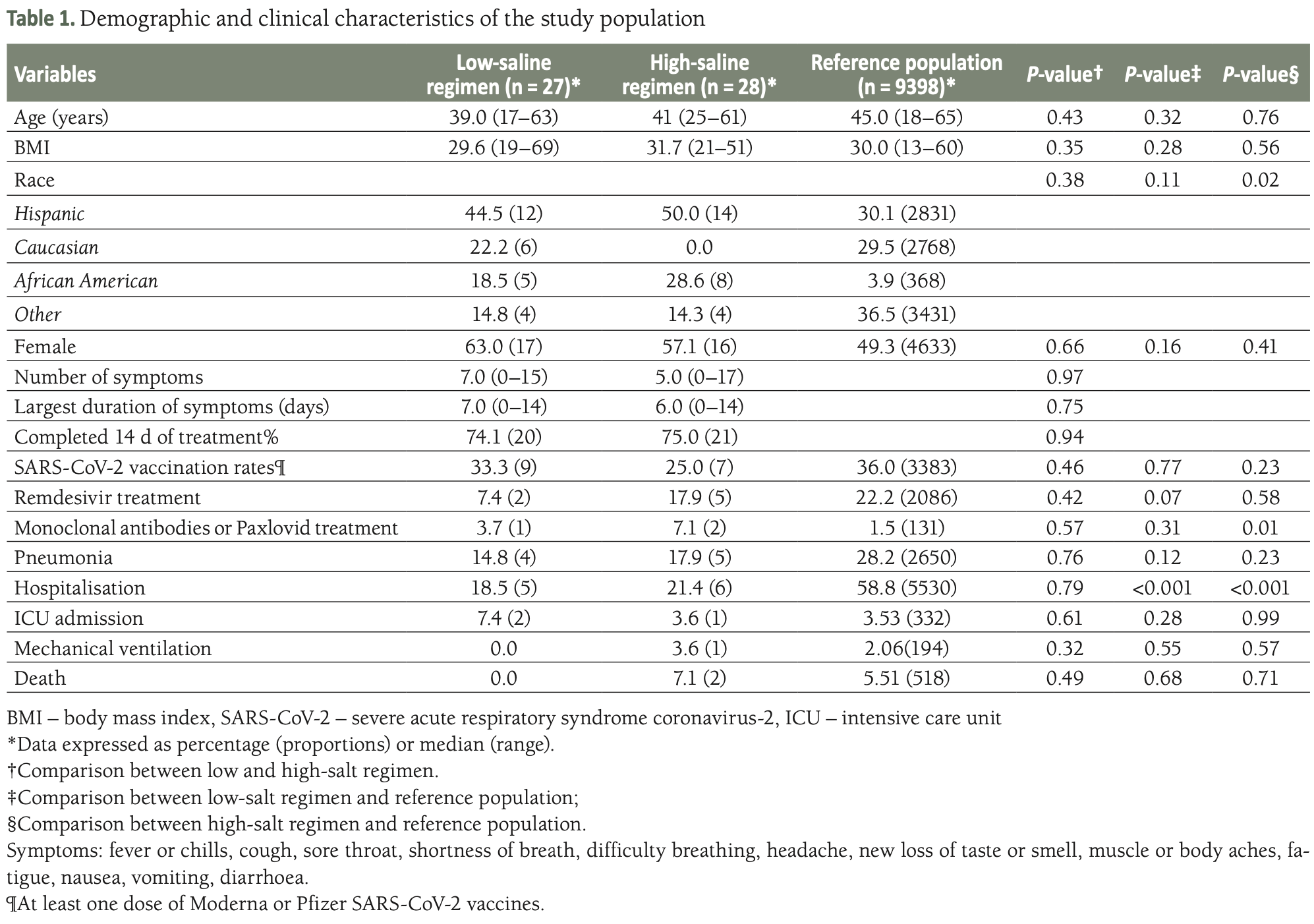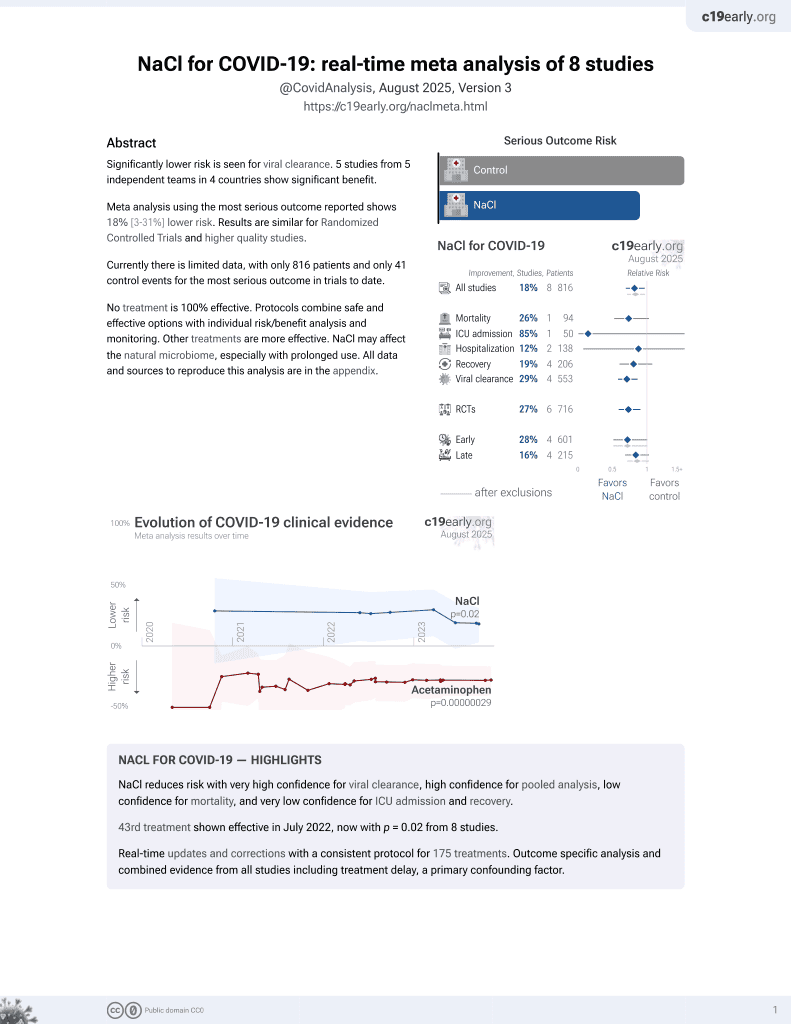
Double-blind randomised trial of saline solution for gargling and nasal rinsing in SARS-CoV-2 infection
et al., Journal of Global Health, doi:10.7189/jogh.14.05044, Dec 2024
NaCl for COVID-19
43rd treatment shown to reduce risk in
July 2022, now with p = 0.0028 from 9 studies.
Lower risk for progression and viral clearance.
No treatment is 100% effective. Protocols
combine treatments.
6,300+ studies for
210+ treatments. c19early.org
|
RCT 58 outpatients showing similar frequencies and durations of COVID-19 symptoms between low-saline and high-saline gargling and nasal rinsing regimens. Both groups followed the same gargling and rinsing protocol for frequency and duration, differing only in salt concentration (6g vs. 2.13g). Both saline regimen groups had significantly lower hospitalization rates compared to a non-predefined reference population from the same institution that did not use these interventions. Patients were enrolled up to 14 days after symptom onset. The specific time frame for the reference population and baseline comorbidity data for the study groups were not provided.
Espinoza et al., 30 Dec 2024, Double Blind Randomized Controlled Trial, USA, peer-reviewed, 7 authors, study period August 2020 - July 2022.
Contact: sebastian.ruben.espinoza@gmail.com.
Double-blind randomised trial of saline solution for gargling and nasal rinsing in SARS-CoV-2 infection
Journal of Global Health, doi:10.7189/jogh.14.05044
Background Previous studies have shown that hypertonic saline nasal irrigation and gargling reduced the duration of symptoms in upper respiratory infections caused by coronavirus. This study aims to investigate the effects of two saline regimens on symptoms associated with severe acute respiratory syndrome coronavirus-2 (SARS-CoV-2). Methods Between 2020 and 2022, individuals aged 18-65 years who tested positive for SARS-CoV-2 infection via polymerase chain reaction (PCR) were randomly assigned to either low-or high-saline regimens for 14 days. The low-saline solutions contained 2.13 g of salt dissolved in eight ounces of warm water, while the high-saline solution contained six grams of salt dissolved in eight ounces of warm water. Participants gargled and rinsed their nasal passages four times a day for 14 days. Primary outcomes assessed included frequency and duration of SARS-CoV-2 symptoms, while secondary outcomes included hospital or intensive care unit (ICU) admission, need for mechanical ventilatory support, or mortality rates. Exclusion criteria included chronic hypertension or participation in other interventional studies. Results Fifty-eight individuals were allocated to the low (n = 27) or high (n = 28) saline regimens; with three lost to follow-up. There were no significant differences in primary or secondary outcomes between these groups. Comparatively, during the study period, 9398 individuals with confirmed SARS-CoV-2 infection by positive PCR test were observed as a reference group. Hospitalisation rates in the low-saline (18.5%) and high-saline (21.4%) regimens were significantly lower than in the reference group (58.8%; P < 0.001), while no significant differences were observed in other outcomes among these groups. Conclusions Low and high saline regimens for gargling and nasal rinsing show similar effectiveness in reducing the frequency and duration of symptoms related to SARS-CoV-2 infection. Both saline regimens are associated with lower hospitalisation rates compared to individuals not using gargling or nasal rinsing in those infected by SARS-CoV-2. © 2024 The Author(s) While severe acute respiratory syndrome coronavirus-2 (SARS-CoV-2) infection is no longer a global health emergency, it still affected around 765 000 000 people, resulting in over 7 000 000 deaths. The coronavirus enters into human cells targeting a specific receptor angiotensin converting enzyme-2, found in certain cells [1]. There is a close genetic similarity between severe acute respiratory syndrome coronavirus (SARS-CoV) and the causative agent of . Diagnostic testing indicates that simple throat swabs provide sufficient sensitivity in detecting SARS-CoV-2 infection during its early stages [2].
Ethics statement: Informed consent was obtained from all participants involved in the study. Authorship contributions: SE, LT, AS, AS, and AE had substantial contributions to the design of the work. JE and AO had substantial contributions to the design of the work, acquisition, analysis, and interpretation of data for the work. All authors assisted in drafting the work or reviewing it critically for important intellectual content, giving the final approval of the version to be published, and agreed to be accountable for all aspects of the work, ensuring that questions related to the accuracy or integrity of any part of the work are appropriately investigated and resolved.
Disclosure of interest: The authors completed the ICMJE Disclosure of Interest Form (available upon request from the corresponding author) and disclose no relevant interests.
DOI record:
{
"DOI": "10.7189/jogh.14.05044",
"ISSN": [
"2047-2978",
"2047-2986"
],
"URL": "http://dx.doi.org/10.7189/jogh.14.05044",
"article-number": "05044",
"author": [
{
"affiliation": [
{
"name": "Trinity University, San Antonio, Texas, USA"
}
],
"family": "Espinoza",
"given": "Sebastian R",
"sequence": "first"
},
{
"affiliation": [
{
"name": "UTHealth|McGovern Medical School, Houston, Texas, USA"
}
],
"family": "Trauffler",
"given": "Lexton",
"sequence": "additional"
},
{
"affiliation": [
{
"name": "Department of Obstetrics and Gynecology, Baylor College of Medicine, Houston, Texas, USA"
}
],
"family": "Shamshirsaz",
"given": "Amir",
"sequence": "additional"
},
{
"affiliation": [
{
"name": "Department of Obstetrics and Gynecology, Harvard Medical School, Boston, Massachusetts, USA"
}
],
"family": "Shamshirsaz",
"given": "Alireza",
"sequence": "additional"
},
{
"affiliation": [
{
"name": "Department of Surgery, Baylor College of Medicine, Houston, Texas, USA"
}
],
"family": "Espinoza",
"given": "Andres",
"sequence": "additional"
},
{
"affiliation": [
{
"name": "Department of Obstetrics and Gynecology, Division of Fetal Intervention, McGovern Medical School, Houston, Texas, USA"
}
],
"family": "Espinoza",
"given": "Jimmy",
"sequence": "additional"
},
{
"affiliation": [
{
"name": "Department of Anesthesiology, Critical Care and Pain Medicine, UTHealth, Houston, Texas, USA"
}
],
"family": "O'Brien",
"given": "Alice",
"sequence": "additional"
}
],
"container-title": "Journal of Global Health",
"container-title-short": "J Glob Health",
"content-domain": {
"crossmark-restriction": false,
"domain": []
},
"created": {
"date-parts": [
[
2024,
12,
30
]
],
"date-time": "2024-12-30T08:18:36Z",
"timestamp": 1735546716000
},
"deposited": {
"date-parts": [
[
2024,
12,
30
]
],
"date-time": "2024-12-30T08:18:39Z",
"timestamp": 1735546719000
},
"indexed": {
"date-parts": [
[
2024,
12,
31
]
],
"date-time": "2024-12-31T05:07:22Z",
"timestamp": 1735621642726,
"version": "3.32.0"
},
"is-referenced-by-count": 0,
"issued": {
"date-parts": [
[
2024,
12,
30
]
]
},
"link": [
{
"URL": "https://jogh.org/2024/jogh-14-05044",
"content-type": "unspecified",
"content-version": "vor",
"intended-application": "similarity-checking"
}
],
"member": "4223",
"original-title": [],
"prefix": "10.7189",
"published": {
"date-parts": [
[
2024,
12,
30
]
]
},
"published-online": {
"date-parts": [
[
2024,
12,
30
]
]
},
"publisher": "International Society of Global Health",
"reference": [
{
"DOI": "10.1038/nature02145",
"article-title": "Angiotensin-converting enzyme 2 is a functional receptor for the SARS coronavirus.",
"author": "Li",
"doi-asserted-by": "crossref",
"first-page": "450",
"journal-title": "Nature",
"key": "key-10.7189/jogh.14.05044-202412300911-R1",
"volume": "426",
"year": "2003"
},
{
"DOI": "10.1038/s41586-020-2196-x",
"article-title": "Virological Assessment of Hospitalized Patients With COVID-2019.",
"author": "Wölfel",
"doi-asserted-by": "crossref",
"first-page": "465",
"journal-title": "Nature",
"key": "key-10.7189/jogh.14.05044-202412300911-R2",
"volume": "581",
"year": "2020"
},
{
"DOI": "10.1155/2022/8794127",
"article-title": "Nasopharyngeal Wash with Normal Saline Decreases SARS-CoV-2 Viral Load: A Randomized Pilot Controlled Trial.",
"author": "Pantazopoulos",
"doi-asserted-by": "crossref",
"first-page": "8794127",
"journal-title": "Can Respir J",
"key": "key-10.7189/jogh.14.05044-202412300911-R3",
"volume": "2022",
"year": "2022"
},
{
"DOI": "10.1007/s00405-024-08518-y",
"article-title": "Seawater nasal wash to reduce symptom duration and viral load in COVID-19 and upper respiratory tract infections: a randomized controlled multicenter trial.",
"author": "de Gabory",
"doi-asserted-by": "crossref",
"first-page": "3625",
"journal-title": "Eur Arch Otorhinolaryngol",
"key": "key-10.7189/jogh.14.05044-202412300911-R4",
"volume": "281",
"year": "2024"
},
{
"DOI": "10.1038/s41598-018-37703-3",
"article-title": "A pilot, open labelled, randomised controlled trial of hypertonic saline nasal irrigation and gargling for the common cold.",
"author": "Ramalingam",
"doi-asserted-by": "crossref",
"first-page": "1015",
"journal-title": "Sci Rep",
"key": "key-10.7189/jogh.14.05044-202412300911-R5",
"volume": "9",
"year": "2019"
},
{
"DOI": "10.1001/archoto.2007.19",
"article-title": "Efficacy of isotonic nasal wash (seawater) in the treatment and prevention of rhinitis in children.",
"author": "Slapak",
"doi-asserted-by": "crossref",
"first-page": "67",
"journal-title": "Arch Otolaryngol Head Neck Surg",
"key": "key-10.7189/jogh.14.05044-202412300911-R6",
"volume": "134",
"year": "2008"
},
{
"DOI": "10.7189/jogh.10.010332",
"article-title": "Hypertonic Saline Nasal Irrigation and Gargling Should Be Considered as a Treatment Option for COVID-19",
"author": "Ramalingam",
"doi-asserted-by": "publisher",
"first-page": "010332",
"journal-title": "J Glob Health",
"key": "key-10.7189/jogh.14.05044-202412300911-R7",
"volume": "10",
"year": "2020"
},
{
"article-title": "Respiratory Tract Infections and Its Preventive Measures Among Hajj Pilgrims, 2010: A Nested Case Control Study.",
"author": "Emamian",
"first-page": "1030",
"journal-title": "Int J Prev Med",
"key": "key-10.7189/jogh.14.05044-202412300911-R8",
"volume": "4",
"year": "2013"
},
{
"DOI": "10.1016/j.amepre.2005.06.013",
"article-title": "Prevention of Upper Respiratory Tract Infections by Gargling A Randomized Trial.",
"author": "Satomura",
"doi-asserted-by": "publisher",
"first-page": "302",
"journal-title": "Am J Prev Med",
"key": "key-10.7189/jogh.14.05044-202412300911-R9",
"volume": "29",
"year": "2005"
},
{
"DOI": "10.1186/1472-6963-8-258",
"article-title": "Cost-effectiveness of Gargling for the Prevention of Upper Respiratory Tract Infections.",
"author": "Sakai",
"doi-asserted-by": "publisher",
"first-page": "258",
"journal-title": "BMC Health Serv Res",
"key": "key-10.7189/jogh.14.05044-202412300911-R10",
"volume": "8",
"year": "2008"
},
{
"DOI": "10.1177/0145561320950491",
"article-title": "Safety and Impact of Nasal Lavages During Viral Infections Such as SARS-CoV-2.",
"author": "Radulesco",
"doi-asserted-by": "publisher",
"first-page": "188S",
"journal-title": "Ear Nose Throat J",
"key": "key-10.7189/jogh.14.05044-202412300911-R11",
"volume": "100",
"year": "2021"
},
{
"DOI": "10.1016/S0025-6196(12)62194-6",
"article-title": "Fatal Hypernatremia From Exogenous Salt Intake: Report of a Case and Review of the Literature.",
"author": "Moder",
"doi-asserted-by": "publisher",
"first-page": "1587",
"journal-title": "Mayo Clin Proc",
"key": "key-10.7189/jogh.14.05044-202412300911-R12",
"volume": "65",
"year": "1990"
},
{
"DOI": "10.3389/fpubh.2023.1161881",
"article-title": "Saline nasal irrigation and gargling in COVID-19: a multidisciplinary review of effects on viral load, mucosal dynamics, and patient outcomes.",
"author": "Huijghebaert",
"doi-asserted-by": "publisher",
"first-page": "1161881",
"journal-title": "Front Public Health",
"key": "key-10.7189/jogh.14.05044-202412300911-R13",
"volume": "11",
"year": "2023"
}
],
"reference-count": 13,
"references-count": 13,
"relation": {},
"resource": {
"primary": {
"URL": "https://jogh.org/2024/jogh-14-05044"
}
},
"score": 1,
"short-title": [],
"source": "Crossref",
"subject": [],
"subtitle": [],
"title": "Double-blind randomised trial of saline solution for gargling and nasal rinsing in SARS-CoV-2 infection",
"type": "journal-article",
"volume": "14"
}
